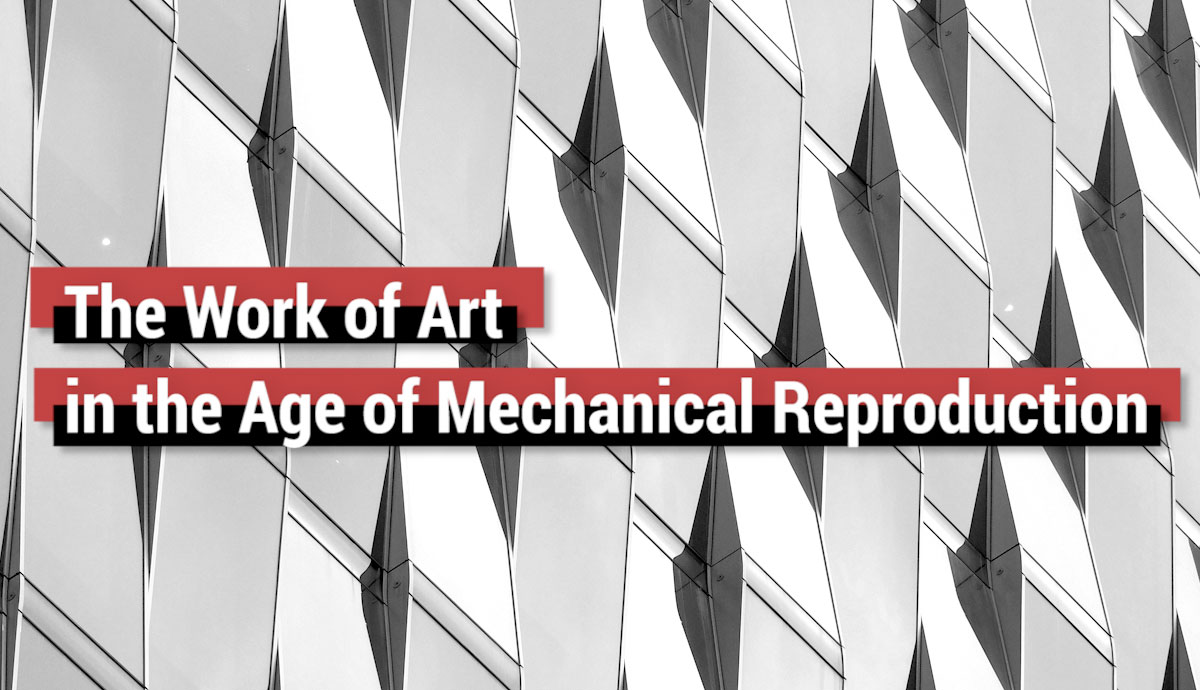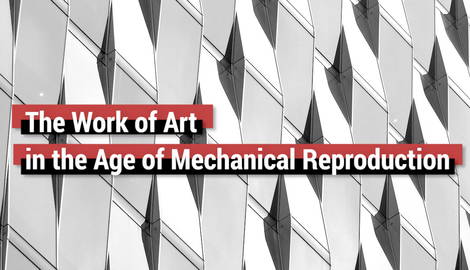
What happens to art when it is copied and multiplied, displayed everywhere, from the museum to your milk box, printed endlessly on t-shirts and stamped on one-dollar mugs? Does art get its gravitas from its uniqueness alone? Is this uniqueness diminished when the work of art is reproduced?
Reproduction is not particularly new. Students copied the works of their masters and masters themselves disseminated their own work as far as they could. What is new is the refinement of technological reproduction, which can now replicate nearly perfectly the parameters of the original artwork. No matter how perfect the reproduction, there is always something missing. Walter Benjamin defends the idea that this missing property which can not be replicated is the unique place and unique existence in time of the original.
“The technology of reproduction detaches the reproduced object from the sphere of tradition. By replicating the work many times over, it substitutes a mass existence for a unique existence. And in permitting the reproduction to reach the recipient in his or her own situation, it actualizes that which is reproduced.”
1. Benjamin on Museums and their Role in Commodifying and Neutralizing Art

In a museum, art follows a particular logic. It forms a coherent flow with the other objects which are displayed and exhibited. Private museums for example serve as a symbol of the wealth and culture of the person who owns it. Art that is displayed there can not be viewed outside of this specific context.
Public museums also serve to showcase the abundance in culture of the particular country in which it is displayed. Collection and accumulation of works of art isn’t random but it serves to tell a story of state or private power. This ahistorical accumulation of time, of objects lifted from their raw context, organized, sorted and displayed on white walls as ornaments of human existence reinforces the cultural hegemony of capital.
This process commodifies and neutralizes art of any subversive potential before it even has the chance of expressing it. Artistic subversion is lost when the work of art is extracted from its cultural, sociological and political relations that make it subversive and is instead placed inside the metanarrative of the modern museum that renders it impotent.
The museum functions like a supermarket accumulating, organizing and displaying whole artistic movements as bit-sized consumable commodities so that the individual can gain some cultural points by knowing about them. This knowledge is detached and cynical with clearly drawn parameters enforced by the topology of the museum itself.
2. Reproduction, Context, and the Artwork’s Aura

While technological reproduction cannot reproduce the specific place and time in which the original existed, it can detach it from its original traditional context. The context is artificially multiplied. Viewing the work next to another work on a museum wall is a different experience from viewing it in the form of a sticker on a car or as part of a movie.
Reproducibility touches upon the essential core of the artwork, its authenticity. For Benjamin ‘the unique value of the “authentic” work of art always has its basis in ritual’ and this basis in ritual is precisely what is threatened by reproduction, which can recontextualise the work of art, emancipating it from the chains of its rituals.
Benjamin sees revolutionary potential in reproduction. It transposes the basis of the artwork from the ritual to the political. The mode of human perception is itself situated in history and in “our” history, it is characterized by a diminishing of the aura of the work of art. The aura for Benjamin is ‘A strange tissue of space and time: the unique apparition of a distance, however near it may be’. There’s a contradiction, Benjamin notes, in the desire of the masses to get closer and closer to the work of art and the desire to abolish their uniqueness through reproduction.
3. The Role of Photography

When photography was becoming widespread, a lot of critics were discussing whether it could be considered art or not. Rather than posing this question, Benjamin wants us to answer another one: what is the effect of photography on the rest of art?
A good place to start is naturalism. As a genre naturalism attempted to emulate and represent nature and people in the least distorted way possible. With photography, what would be the point of it? Art became more abstract. In a way, photography freed art from its naturalistic constraints, from its need to represent everything the way it was.
Now art could (and had to) dare to say something else, something which could not be captured by the camera but only by the artist. Our notion of representation itself changed with it, it started to move from a reproductive character which saw representation as a mechanical mirroring of the aspects of the original to a more symbolic representation, a representation which often tried to say more about the original than what the original could say about itself.
Kandinsky is one such example of this evolution of art. He is cited as the father of abstract paintings. “Abstract” however doesn’t fully capture what was going on. Art didn’t simply become non-concrete but it became so in order to escape the gaze of the camera. It started to look deeper for motives, new ways of expression, new ways of speaking. It also entered into communication with itself, a communication which wasn’t readily accessible to the masses. This was in contrast with photography, which Benjamin asserts started to be evermore commodified with time.
4. Fascism, capitalism, and the (De)Politicization of Art

For Benjamin, art is fundamentally political and as such it should be situated in history. The ruling classes convey a notion of art which is tied to tradition and unchanging. It has a uniqueness of irreducible aura which can not be duplicated.
Through reproduction, the work of art is democratized. Reproduction threatened the values of the status quo which were based precisely on the unchangeability of the work of art, its persistence and ahistorical essence. In an attempt to give the masses some sense of change and progress, whilst offering no change in the social relations of property, fascism aestheticizes politics itself. In response, communism politicized art.
Benjamin also attacks futurism and its glorification of war and domination. Fascism forms a mythology of itself, relying on a reactionary imagination of values which are mobilized against any progressive forces, social or economic. Fascism relies on art which can be said to be objectively good because it reflects what fascists value. Whilst fascism relies on a fictive past, a nostalgia for a time which never existed, capitalism strips the subversive potential of non-ritual-based art and turns it into a spectacle which becomes a mere distraction for the masses.
“The destruction of the aura is the mark of a perception whose sense of the sameness of things has grown to the point where even the singular, the unique, is divested of its uniqueness—by means of its reproduction.”
Unable to contain the democratization of the work of art, its loss of aura which holds in its fixed traditional lineage, capitalism turns it into a commodity to render its subversive potential useless, while fascism reacts by aestheticizing the political itself.
5. Walter Benjamin on the Weight of History

Besides politicizing art, Benjamin wants to historicize it to highlight the practices behind its production, the social relations which manufacture the need for the artist to express himself/herself a certain way instead of another.
History is driven by its inner contradictions, the tension which exists in the very fabric of society: tension between a worker and an owner, between the state and the masses, between art and the artist, between art’s history and its progress. Benjamin’s reading of history is a critique of those thinkers who have reduced historical materialism to a deterministic, physicalist theory by appropriating and magnifying its most vulgar aspects.
Benjamin wants to save history from the ahistorical. Through this understanding of history art is freed from its fixed place, given space, and even taken seriously – as capable of affecting change.

In the Fascist conception of history, subjugation is glorified and hierarchies romanticized through art. Art itself becomes a tool, not of expression but one of exerting power from above. The basic structure of history as conceived by fascism is that of a harmonious past where people followed traditional moral values until the ‘other’ infiltrated said society and started ruining it from within. Fascism is ultimately a conspiracy theory which is entangled in its own mysticism which can explain all events as following from the infiltration of the other.
This mysticism provides a framework for justifying their own violence as a quasi-immunological reaction, like a healthy body fighting off a virus which is trying to destroy it from within. This justified the Fascist reaction to what it saw as “degenerate” art, which was any work of art that dared to transgress the established values of the fascist regime. These tendencies can still be seen in contemporary reactionary spaces, for example with the violent resistance to LGBT+ representation on TV or representation of any other marginalized group, any “Other” which infiltrates the spaces of the media they consume.










